All truly great thoughts are conceived by walking.- Nietzsche
And there's no city more built for walking than
Jerusalem.
I was experiencing less tension than I expected. Walking around Jerusalem proved easier than I had thought. The scene of the worst suicide-bombing campaign ever a few years ago (imagine a 9/11 attack every month) was remarkably calm. The tourists haven't returned to Jerusalem in quite the numbers you see elsewhere in Israel. And there's more self-segregation by neighborhood now than 20 years ago - religious Jews of different tendencies keep to their own neighborhoods, more liberal or secular Jews in theirs - all Jews on the western or "new" city side (or in the western suburbs) - and all Arabs on the eastern side ("east" Jerusalem), as well as the Old City in the middle. Jerusalem is an avocado with a Jewish half to the west, northwest, and north; an Arab half to the east, northeast, and southeast; with the Old City as the "pit" at the center. The Old City was the only part that survived for many centuries, until just before World War One. Its present walls were built in the sixteenth century by an Ottoman emperor.
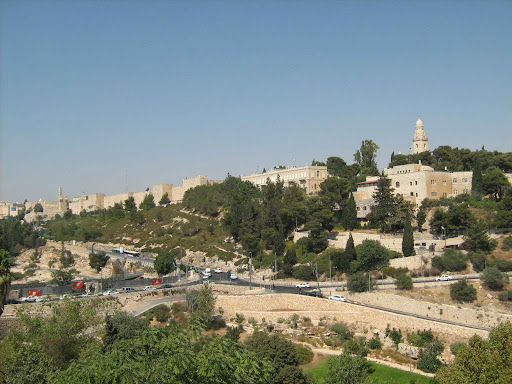
It's also one of the most hauntingly beautiful places you'll ever see. It's a fragile sort of beauty, and elusive. Much of it has to do with the quality of its light. Americans living in northern California or northern New England (in the summer and fall) are a little familiar with this light. But in those places, it's connected with being on the water. Except for the Dead Sea off in the distance, there's no body of water here.*
I walked all over, mostly the Jewish western part, with part of one day in the narrow streets and alleys of the Old City. It was all familiar, since I lived for one summer in Jerusalem and visited twice again later. At the same time, much has changed. The arrival of the Russian Jews in the 1990s meant that English was no longer the unchallenged second language it had once been. You also don't have to listen for long to hear another second language, French, the product of a more recent wave of French Jews - some neighborhoods of Jewish west Jerusalem are now heavily French. The amount of construction was startling - new buildings, new and improved roads, new hotels, etc. The western suburbs have expanded, and the more modern parts of Jerusalem even have traffic jams now.
I didn't walk as much in east Jerusalem, but I did pass through it on my way out and around the Old City. It too has grown and modernized - new shops, new hotels, modern taxis and buses - very different from 20 years ago when I first visited. It makes you wonder about the radically misleading stuff you get on television. Free of context or accurate explanation, such experiences bring home how much television news is junk food. In the case of the 2001-2004 terror war (second intifada), you never see the ordinariness of life at all.
But there are reminders of the terror war here. Security is far more in-your-face than in Tel Aviv or Eilat. Restaurants, banks, and stores all have guards. The public buses spot check people as they board. The impressive new bus station also has very obvious security, although nothing onerous. Near the Old City, if you look out northeast or southeast, you can see the security "fence" or "wall" that divides Israel proper (more or less) from the Palestinian areas of the West Bank. The combination of this fence and the active security measures have prevented anyone from pulling off a suicide bombing here since 2004.
The combination of self-segregation, security, and residual fear has put a damper on the economy in and around Jerusalem. While the western edges and suburbs of the city are thriving, the Old City even now lacks the level of tourism it had before 2001. The security restrictions also dampen the Palestinian Arab economy in east Jerusalem and the West Bank. When I walked into the Old City, past the narrow market (
shuq or
suq), shopkeepers descended all with they claimed were great deals. The
Armenian quarter (the
smallest of the four) was quieter, with fewer shops and, I suspect, less economic desperation. The
Armenian community here is small but old and has strong connections with both Armenia and the Armenian diaspora. Fundraising among Armenian-Americans had made possible a beautiful renovation of the Quarter's
Gulbenkian library.
Around the "corner," past the Zion Gate along the southern wall, and you reach the Jewish Quarter. After the Jordanians captured the Old City in 1949, this quarter was demolished, only to be rebuilt after Jerusalem was reunified in 1967. It didn't look that different from the 1980s - until I reached the Temple Mount plaza. The plaza in front of the Western or "Wailing" Wall, the prime focus of Jewish worship as the last remains of the Second Temple, had been rebuilt, as well as guarded by an elaborate security gate. Up on the ramparts of the Temple Mount compound itself was the
controversial new construction by the Muslim Waqf (religious endowment) that controls the compound itself and its buildings.

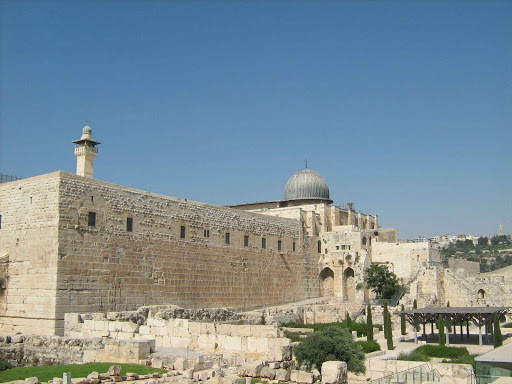
This area (the Haram es-Sharif, or Noble Sanctuary) is the site of the Dome of the Rock, once a mosque, now a museum (that's the gold-domed building) and the Al-Aqsa Mosque, the silver-domed building on the southern end of the compound overlooking the new archeological park.
The Jewish western city is much more modern and secular. Although few countries recognize Jerusalem as Israel's capital, virtually all governmental functions have moved here from Tel Aviv in the last 40 years. It boasts the Israel Museum and countless other world-class institutions, including the two-campus Hebrew University. It even boasts real nightlife now - real nightclubs, as well as the famous Ben Yehuda pedestrian mall that comes alive after the sabbath ends Saturday evening.** Nonetheless, Jerusalem is a definitely more conservative, family-oriented place than Tel Aviv, which by default, is Israel's capital of commerce and secular culture. (Unlike Tel Aviv, Jerusalem has no nude beaches :) Given that Jerusalem's secular population is declining as a fraction of the whole and the city's evident self-segregation - religious versus secular, Jewish versus Arabic, "official" Jerusalem versus "ordinary" Jerusalem - it's a wonder that the city has flourished. But it has.
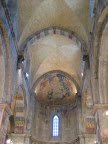
POSTSCRIPT: A Sunday afternoon trip (a work day for Israelis) took me to Abu Ghosh, a charming Arab town a little west of Jerusalem. Israelis are no longer comfortable walking around the Old City, so they flock to Abu Ghosh instead. Today it's all Muslim, but there remain two beautiful churches, both once Greek (Byzantine) sites, now controlled by the French Catholic order of the Lazarist Brothers. Although it was officially closed, the abbot of the lower one (Church of the Resurrection) let me in to walk around, both inside and out. He spoke no English, so we conversed in limited doses of French and Hebrew. Here is the sanctuary, an interesting mix of Byzantine architecture and Roman Catholic (western) art and furnishings. The acoustics are fantastic, and the sanctuary is home to frequent concerts.
---
* The
Dead Sea is an odd duck even among salt water lakes. Part of the
Great Rift that runs up from east Africa, it's the lowest land point on the Earth's surface. The sea is so laden with salts that you can easily float on its surface; its name in Hebrew is Salt Sea. It's fed by the
Jordan River, but there so much water being diverted now from this system, that the Jordan in places is more brook than river, and the Dead Sea has now shrunk to three separate puddles. See
here.
** The most fun new nightclub in Jerusalem is
The Lab, on the grounds of the old railroad station. It's complete with mosh pit and greeters at the door, in white lab coats, who hand out drinks served in beakers and testtubes. There are sex, drugs, and rock-n-roll in the Holy City; they're just more discreet. And getting wasted in Jerusalem is - well -
different from getting wasted anywhere else.
Labels: Israel, Jerusalem, Palestinians, travel
 Some important developments in the ongoing critique of the "global warming" craze are worth noting and adding to previous postings on popular and semi-popular expositions of climate and climate change. These Halloween specials are connected to the 18th Chicago Humanities Festival, held at various cultural institutions around the great city. The 2007 festival features as speakers two important long-time climate hysteria critics.
Some important developments in the ongoing critique of the "global warming" craze are worth noting and adding to previous postings on popular and semi-popular expositions of climate and climate change. These Halloween specials are connected to the 18th Chicago Humanities Festival, held at various cultural institutions around the great city. The 2007 festival features as speakers two important long-time climate hysteria critics.
 A warming of the Arctic (at least a mild warming) would be a boon for the bears, since they range mostly over land and feed on aquatic creatures along the shore, like fish and seals. Less ice -> more food for the bears. The warming trends are
A warming of the Arctic (at least a mild warming) would be a boon for the bears, since they range mostly over land and feed on aquatic creatures along the shore, like fish and seals. Less ice -> more food for the bears. The warming trends are  Posters like this are common in Nunavut, the Canadian province newly created from the Northwest Territories for the Inuit. The strange symbols are a modern alphabet for the Inuit language. A polar bear wandering through town was recently shot dead in
Posters like this are common in Nunavut, the Canadian province newly created from the Northwest Territories for the Inuit. The strange symbols are a modern alphabet for the Inuit language. A polar bear wandering through town was recently shot dead in 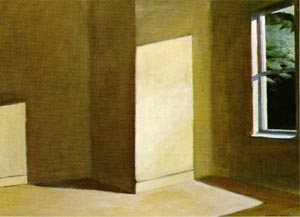



 This area (the Haram es-Sharif, or Noble Sanctuary) is the site of the Dome of the Rock, once a mosque, now a museum (that's the gold-domed building) and the Al-Aqsa Mosque, the silver-domed building on the southern end of the compound overlooking the new archeological park.
This area (the Haram es-Sharif, or Noble Sanctuary) is the site of the Dome of the Rock, once a mosque, now a museum (that's the gold-domed building) and the Al-Aqsa Mosque, the silver-domed building on the southern end of the compound overlooking the new archeological park. POSTSCRIPT: A Sunday afternoon trip (a work day for Israelis) took me to Abu Ghosh, a charming Arab town a little west of Jerusalem. Israelis are no longer comfortable walking around the Old City, so they flock to Abu Ghosh instead. Today it's all Muslim, but there remain two beautiful churches, both once Greek (Byzantine) sites, now controlled by the French Catholic order of the Lazarist Brothers. Although it was officially closed, the abbot of the lower one (Church of the Resurrection) let me in to walk around, both inside and out. He spoke no English, so we conversed in limited doses of French and Hebrew. Here is the sanctuary, an interesting mix of Byzantine architecture and Roman Catholic (western) art and furnishings. The acoustics are fantastic, and the sanctuary is home to frequent concerts.
POSTSCRIPT: A Sunday afternoon trip (a work day for Israelis) took me to Abu Ghosh, a charming Arab town a little west of Jerusalem. Israelis are no longer comfortable walking around the Old City, so they flock to Abu Ghosh instead. Today it's all Muslim, but there remain two beautiful churches, both once Greek (Byzantine) sites, now controlled by the French Catholic order of the Lazarist Brothers. Although it was officially closed, the abbot of the lower one (Church of the Resurrection) let me in to walk around, both inside and out. He spoke no English, so we conversed in limited doses of French and Hebrew. Here is the sanctuary, an interesting mix of Byzantine architecture and Roman Catholic (western) art and furnishings. The acoustics are fantastic, and the sanctuary is home to frequent concerts. Were there crocs everywhere in the Middle East? Or just the desert? (Isn't it all desert? No, actually, it isn't.) They are comfortable in the desert. They protect your feet against burning sand, while still "breathing." So it's natural the Beduin would want them. They do what a good pair of sandals do, only better. I saw them in Eilat, of course, especially on and near the beach. But I saw them even in Jerusalem, and there they seemed pretty out of place. Maybe crocs just aren't respectful enough for the Holy City.*
Were there crocs everywhere in the Middle East? Or just the desert? (Isn't it all desert? No, actually, it isn't.) They are comfortable in the desert. They protect your feet against burning sand, while still "breathing." So it's natural the Beduin would want them. They do what a good pair of sandals do, only better. I saw them in Eilat, of course, especially on and near the beach. But I saw them even in Jerusalem, and there they seemed pretty out of place. Maybe crocs just aren't respectful enough for the Holy City.* The best coffee experience on my trip: I got better-than-decent espresso and cappuccino in Erice (Sicily). But nothing can top the Beduin coffee at the Aqaba-Eilat border crossing. The shop owner obviously lucked out with an exclusive concession. He had the usual tourist stuff - postcards, film, batteries, T-shirts, plus more of that old Ottoman bric-a-brac (non-functional rifle, Turkish sword, narghila or hookah for flavored tobacco). But in the back was the classic Bedu brass coffee pot over an open fire. The coffee had a slight hint of mocha and, most critically, was continually stirred and swished around - that way, it ends up thick but not sludgy. Served with a slight touch of lemony essence, no other coffee touches it. And a demitasse of it is enough to keep you going all morning.
The best coffee experience on my trip: I got better-than-decent espresso and cappuccino in Erice (Sicily). But nothing can top the Beduin coffee at the Aqaba-Eilat border crossing. The shop owner obviously lucked out with an exclusive concession. He had the usual tourist stuff - postcards, film, batteries, T-shirts, plus more of that old Ottoman bric-a-brac (non-functional rifle, Turkish sword, narghila or hookah for flavored tobacco). But in the back was the classic Bedu brass coffee pot over an open fire. The coffee had a slight hint of mocha and, most critically, was continually stirred and swished around - that way, it ends up thick but not sludgy. Served with a slight touch of lemony essence, no other coffee touches it. And a demitasse of it is enough to keep you going all morning.

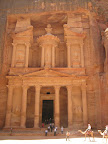
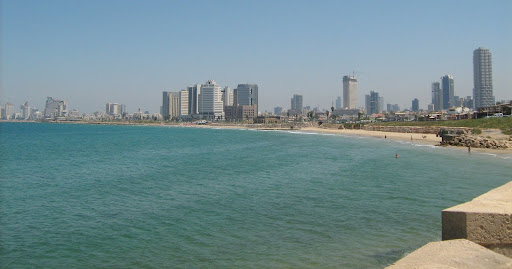 My next stop was
My next stop was  It was probably the same whale making his rounds and showing up in all the stories.
It was probably the same whale making his rounds and showing up in all the stories.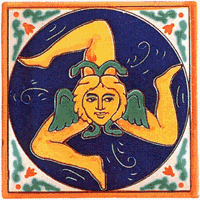 This southwest-facing coast is not as famous as the Greek-influenced southeast corner and lacks its own Mount Etna. But you've heard of some of this part of Sicily, although perhaps not with that association. It's a part of the island first colonized by the Carthaginians around 800 BCE, itself a North African colony founded in 814 BCE by the Phoenician city of Tyre back in what is today Lebanon. Sicily is three-cornered, with coasts facing north, southwest, and southeast. The northern coast was originally the least developed part, the home of a mysterious people the Romans called the Siculi, for whom the island was named. Over the millennia, Sicily has been ruled by Carthaginians, Greeks, Romans, Greeks again, Arabs from North Africa, the Normans, the Spanish, and finally by the modern Italian republic.
This southwest-facing coast is not as famous as the Greek-influenced southeast corner and lacks its own Mount Etna. But you've heard of some of this part of Sicily, although perhaps not with that association. It's a part of the island first colonized by the Carthaginians around 800 BCE, itself a North African colony founded in 814 BCE by the Phoenician city of Tyre back in what is today Lebanon. Sicily is three-cornered, with coasts facing north, southwest, and southeast. The northern coast was originally the least developed part, the home of a mysterious people the Romans called the Siculi, for whom the island was named. Over the millennia, Sicily has been ruled by Carthaginians, Greeks, Romans, Greeks again, Arabs from North Africa, the Normans, the Spanish, and finally by the modern Italian republic. August in Sicily is hot, tending toward the humid, with strong sea breezes. But Sicily is also subject to the powerful north African
August in Sicily is hot, tending toward the humid, with strong sea breezes. But Sicily is also subject to the powerful north African 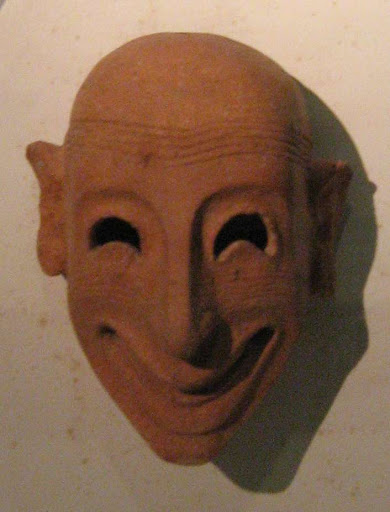 In spite of the heat, I walked all around our mountain town of Erice every day, enjoying the amazing Sicilian food, and took a part of day to hike down to
In spite of the heat, I walked all around our mountain town of Erice every day, enjoying the amazing Sicilian food, and took a part of day to hike down to 
